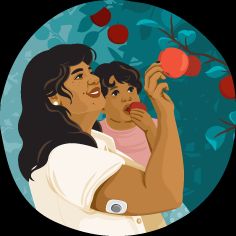“Blue Zones” are geographic areas with lower rates of chronic diseases and longer life expectancy. Diet, fasting, and exercise are factors associated with Blue Zones. Italy, Greece, Japan, Costa Rica, and the United States have Blue Zones.
Chronic diseases are becoming more and more common in old age.
While genetics somewhat determine your life span and susceptibility to these diseases, your lifestyle probably has a greater impact.
A few places in the world are called “Blue Zones.” The term refers to geographic areas in which people have low rates of chronic disease and live longer than anywhere else.
This article describes the common lifestyle features of people in Blue Zones, including why they live longer.

“Blue Zone” is a nonscientific term given to geographic regions that are home to some of the world’s oldest people.
It was first used by the author Dan Buettner, who was studying areas of the world in which people live exceptionally long lives.
They are called Blue Zones because when Buettner and his colleagues were searching for these areas, they drew blue circles around them on a map.
In his book called “The Blue Zones,” Buettner described five known Blue Zones:
- Icaria (Greece): Icaria is an island in Greece where people eat a Mediterranean diet rich in olive oil, red wine, and homegrown vegetables.
- Ogliastra, Sardinia (Italy): The Ogliastra region of Sardinia is home to some of the oldest men in the world. They live in mountainous regions where they typically work on farms and drink lots of red wine.
- Okinawa (Japan): Okinawa is home to the world’s oldest women, who eat a lot of soy-based foods and practice tai chi, a meditative form of exercise.
- Nicoya Peninsula (Costa Rica): The Nicoyan diet is based around beans and corn tortillas. The people of this area regularly perform physical jobs into old age and have a sense of life purpose known as “plan de vida.”
- The Seventh-day Adventists in Loma Linda, California (USA): The Seventh-day Adventists are a very religious group of people. They’re strict vegetarians and live in tight-knit communities.
Although Buettner’s book discusses only these areas, there may be unidentified areas in the world that could also be Blue Zones.
A number of studies have found that these areas contain extremely high rates of nonagenarians and centenarians, which are people who live over 90 and 100, respectively (
Interestingly, genetics probably only account for 20% to 30% of longevity. So, environmental influences, including diet and lifestyle, play a huge role in determining your life span (
Below are some of the diet and lifestyle factors that are common to people who live in Blue Zones.
One thing common to Blue Zones is that those who live there primarily eat a 95% plant-based diet.
Although most groups are not strict vegetarians, they only tend to eat meat around five times per month (
A number of studies, including one in over half a million people, have shown that avoiding red meat and processed meat can significantly reduce the risk of death from heart disease, cancer, and a number of other different causes (
Instead, diets in the Blue Zones are typically rich in the following:
- Vegetables: They’re a great source of fiber and many different vitamins and minerals. Eating more than five servings of fruits and vegetables a day can significantly reduce your risk of heart disease, cancer, and death (
11Trusted Source ). - Legumes: Legumes include beans, peas, lentils, and chickpeas, and they’re all rich in fiber and protein. A number of studies have shown that eating legumes is associated with lower mortality (
12Trusted Source ,13Trusted Source ,14Trusted Source ). - Whole grains: Whole grains are also rich in fiber. A high intake of whole grains can reduce blood pressure and is associated with reduced colorectal cancer and death from heart disease (
15Trusted Source ,16Trusted Source ,17Trusted Source ). - Nuts: Nuts are great sources of fiber, protein, and polyunsaturated and monounsaturated fats. Combined with a healthy diet, they’re associated with reduced mortality and may even help reverse metabolic syndrome (
18Trusted Source ,19Trusted Source ,20Trusted Source ).
There are some other dietary factors that define each of the Blue Zones.
For example, fish is often eaten in Icaria and Sardinia. It’s a good source of omega-3 fats, which are important for heart and brain health (
Eating fish is associated with slower brain decline in old age and reduced heart disease (
Other habits common to the Blue Zones are reduced calorie intake and fasting.
Calorie restriction
Long-term calorie restriction may help longevity.
A large, 25-year study in monkeys found that eating 30% fewer calories than normal is associated with a significantly longer life (
Eating fewer calories may be contributing to the longer lives in some of the Blue Zones.
For example, studies in the Okinawans suggest that before the 1960s, they were in a calorie deficit, meaning that they were eating fewer calories than they required, which may be contributing to their longevity (
Furthermore, Okinawans tend to follow the 80% rule, which they call “hara hachi bu.” This means that they stop eating when they feel 80% full, rather than 100% full.
This prevents them from eating too many calories, which can lead to weight gain and chronic disease.
A number of studies have also shown that eating slowly can reduce hunger and increase feelings of fullness, compared to eating rapidly (
This may be because the hormones that make you feel full only reach their maximum blood levels 20 minutes after you eat (
Therefore, by eating slowly and only until you feel 80% full, you may eat fewer calories and feel full longer.
Another important part of the Blue Zone meal plan is to eat your smallest meal in the late afternoon or early evening and then not eat for the rest of the day (30).
Another dietary factor common to many of the Blue Zones is moderate alcohol consumption.
There’s mixed evidence about whether moderate alcohol consumption reduces the risk of death.
Many studies have shown that drinking one to two alcoholic drinks per day can significantly reduce mortality, particularly from heart disease (
However, a very recent study suggested that there’s no real effect once you take into consideration other lifestyle factors (
The beneficial effect of moderate alcohol consumption may depend on the type of alcohol. Red wine may be the best type of alcohol, given that it contains many antioxidants from grapes.
Consuming one to two glasses of red wine per day is particularly common in the Icarian and Sardinian Blue Zones.
In fact, Sardinian Cannonau wine, which is made from Grenache grapes, has been shown to have extremely high levels of antioxidants, compared to other wines (
Antioxidants help prevent damage to DNA that can contribute to aging. Therefore, antioxidants may be important for longevity (
A couple of studies have shown that drinking moderate amounts of red wine is associated with a slightly longer life (
However, as with the other studies on alcohol consumption, it’s unclear whether this effect is because wine drinkers also tend to have healthier lifestyles (
Other studies have shown that people who drank a 5-ounce (150-ml) glass of wine every day for 6 months to 2 years had significantly lower blood pressure, lower blood sugar, more “good” cholesterol, and improved sleep quality (
It’s important to note that these benefits are only seen for moderate alcohol consumption. Each of these studies also showed that higher levels of consumption actually increase the risk of death (
Aside from diet, exercise is another extremely important factor in aging (
In the Blue Zones, people don’t exercise purposefully by going to the gym. Instead, it’s built into their daily lives through gardening, walking, cooking, and other daily chores.
A study of men in the Sardinian Blue Zone found that their longer lives were associated with raising farm animals, living on steeper slopes in the mountains, and walking longer distances to work (
A study of more than 13,000 men showed that these habitual activities benefit them. The amount of distance they walked or stories of stairs they climbed each day predicted how long they would live (
Other studies have shown the benefits of exercise in reducing the risk of cancer, heart disease, and overall death.
The current recommendations from the Physical Activity Guidelines for Americans suggest a minimum of 75 vigorous-intensity or 150 moderate-intensity minutes of aerobic activity per week.
A large study including over 600,000 people found that those doing the recommended amount of exercise had a 20% lower mortality rate than those who did no physical activity (
Another large study found that vigorous activity led to a lower mortality rate among the participants than moderate activity (
In addition to exercise, getting adequate rest and a good night’s sleep also seems to be very important for living a long and healthy life.
People in Blue Zones get sufficient sleep and also often take daytime naps.
A number of studies have found that not getting enough sleep, or getting too much sleep, can significantly increase the risk of death, including from heart disease or stroke (
A large analysis of 35 studies found that 7 hours was the optimal sleep duration. Sleeping a lot less or a lot more than that was associated with an increased risk of death (
In the Blue Zones, people tend not to go to sleep, wake up,, or go to work at set hours. They just sleep as much as their bodies tell them to.
In certain Blue Zones, such as Icaria and Sardinia, daytime napping is also common.
A number of studies have shown that daytime naps, known in many Mediterranean countries as “siestas,” have no negative effect on the risk of heart disease and death and may even reduce these risks (
However, the length of the nap appears to be very important. Naps of 30 minutes or less may be beneficial, but anything longer than 30 minutes is associated with an increased risk of heart disease and death (
Aside from diet, exercise, and rest, a number of other social and lifestyle factors are common to the Blue Zones and they may contribute to the longevity of the people living there.
These include:
- Being religious or spiritual: Blue Zones are typically religious communities. A number of studies have shown that being religious is associated with a lower rate of death. This may be due to social support and reduced rates of depression (
50Trusted Source ). - Having a life purpose: People in Blue Zones tend to have a life purpose, known as “ikigai” in Okinawa or “plan de vida” in Nicoya. This is associated with a reduced risk of death, possibly through psychological well-being (
51Trusted Source ,52Trusted Source ,53Trusted Source ). - Older and younger people living together: In many Blue Zones, grandparents often live with their families. Studies have shown that grandparents who look after their grandchildren have a higher chance of living longer (54).
- A healthy social network: Your social network, called “moai” in Okinawa, can affect your health. For example, if your friends are obese, you have a greater risk of being obese, possibly through social acceptance of weight gain (
55Trusted Source ).
The Blue Zone regions are home to some of the oldest and healthiest people in the world.
Although their lifestyles differ slightly, they mostly eat a plant-based diet, exercise regularly, drink moderate amounts of alcohol, get enough sleep, and have good spiritual, family, and social networks.
Each of these lifestyle factors has been shown to be associated with a longer life.
By incorporating them into your lifestyle, it may be possible for you to have a longer life span.




